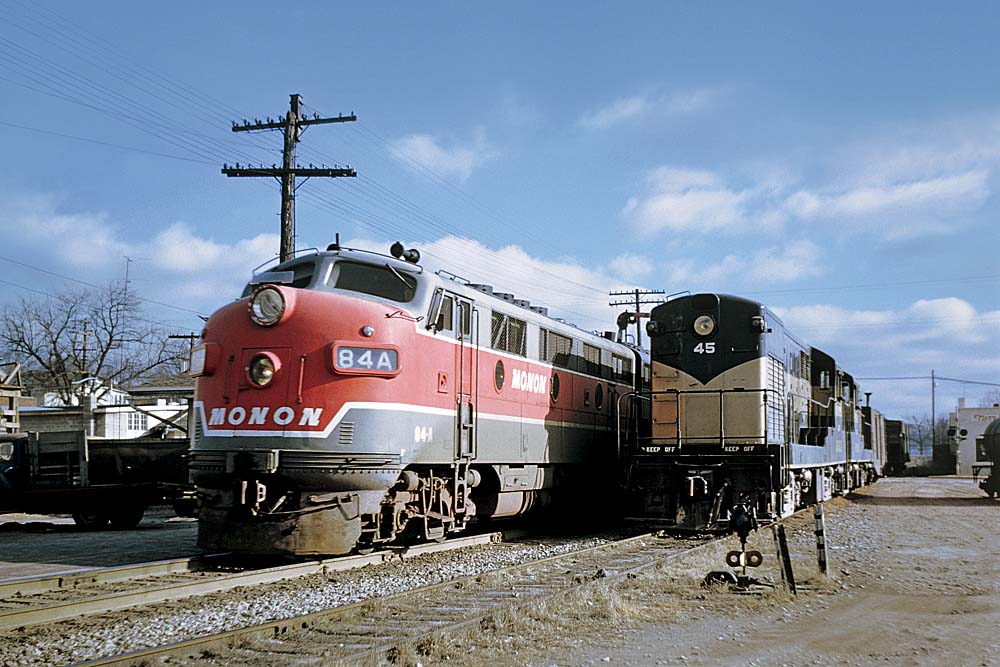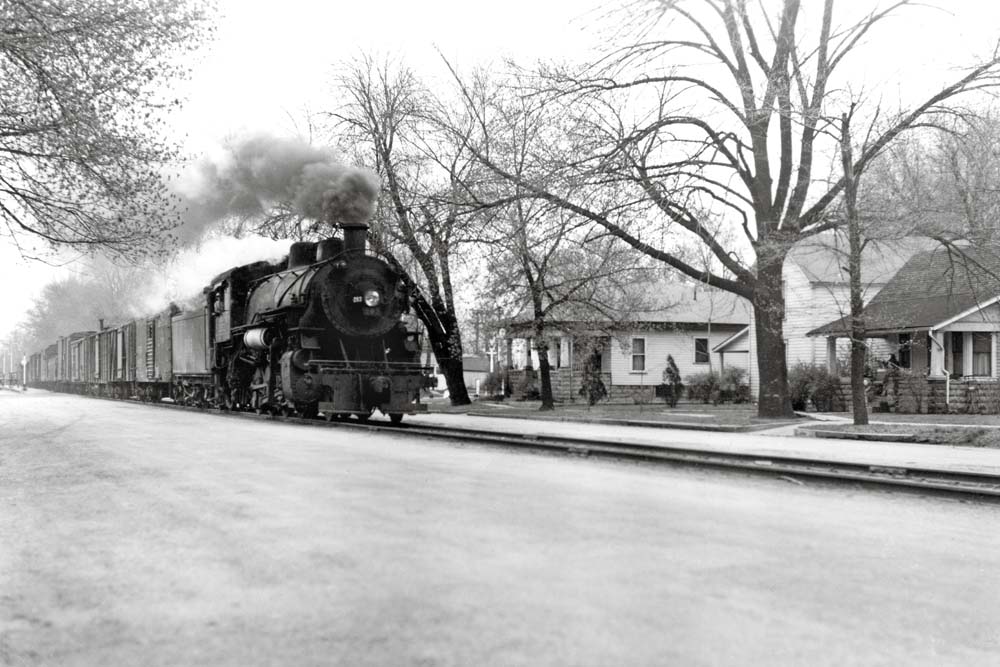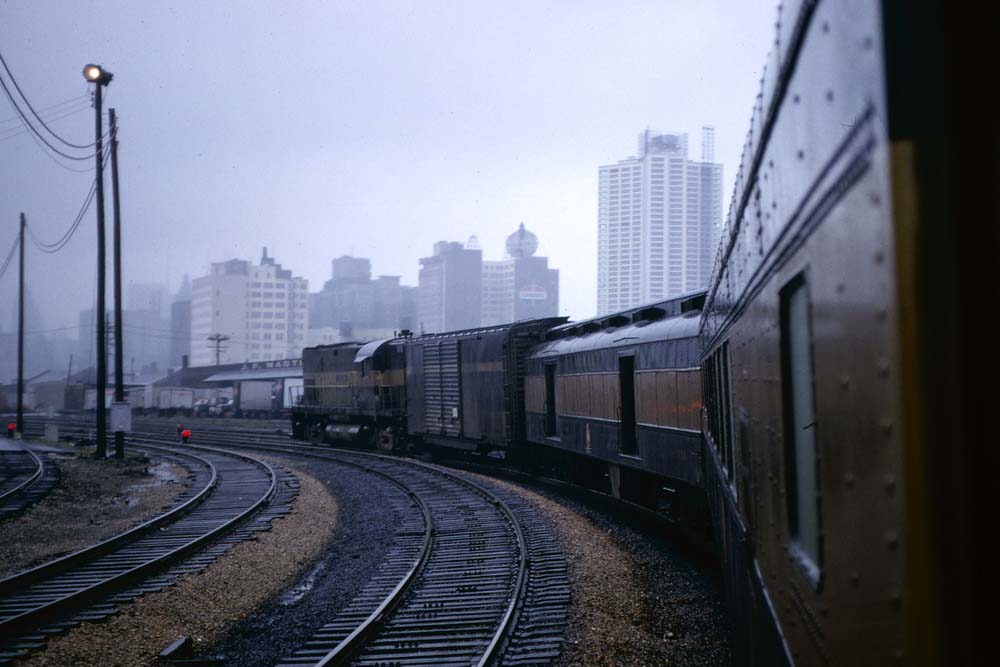Monon Railroad history is tied to Indiana state history.
Imagine a meandering Midwestern railway constructed through difficult, sparsely settled territory and soon bankrupt as a result, discovering upon completion that it had been built between the wrong cities. It would attempt to rectify early mistakes through expensive acquisitions of adjoining railroads, and trackage rights on others, struggling to compete against larger systems on its two primary routes while encountering only marginal success in originating traffic. On several occasions it would achieve varying degrees of prosperity, only to repeatedly succumb to bankruptcy. Then, after World War II it would enjoy improbable salvation and modernization under one of the industry’s most gifted leaders — only to be merged out of existence three decades later and largely dismembered.
That seemingly implausible scenario accurately summarizes the highs-and-lows history of Indiana’s beloved Monon Railroad. It was an engaging melodrama, one that entertained Hoosiers and frustrated investors for 124 years.
In 1847, the starting point of merchant James Brooks’ New Albany & Salem Rail Road was Indiana’s then largest city, a key port across the Ohio River from Louisville, Ky. Brooks had reasoned that a railroad built on the grade of a stillborn highway project from New Albany to Salem, the next county seat north, could profitably carry finished goods into the developing Hoosier hinterlands and return a steady supply of raw materials to waiting river packets. By 1851 the fledging enterprise had completed 35 miles of curving trackage between its namesake towns. Brooks then revealed plans to extend his pioneer road to the Lake Michigan docks of Michigan City, 288 miles from the Ohio River.
As completed in 1854, the NA&S comprised a twisting, grade-laden railroad from New Albany to the mid-state village of Bainbridge, with largely flat and straight trackage from there to Michigan City. Neither segment generated sufficient traffic to sustain the company, though, and bankruptcy claimed both Brooks and his railroad in 1859. After new management took control, the NA&S was renamed Louisville, New Albany & Chicago Railway, a title embracing two emerging metropolises the company desperately needed to serve if it were to survive.
Two decades of dormancy and two more foreclosures followed before the LNA&C acquired the equally struggling Chicago & Indianapolis Air Line Railway in 1881. The two crossed at a hamlet that had adopted the name of neighboring Monon Creek. Monon [MOE-nahn] was a Potawatomi word meaning “swift running,” a term applicable at the time to neither railroad. Nevertheless, the expanded company was soon being called “The Monon Route.”
By 1882 the former Air Line had been extended southeast to Indiana’s capital and largest city, Indianapolis, and northwest to Hammond, Ind., and its State Line Crossing connection with the Chicago & Western Indiana on to Dearborn Station in Chicago. During 1883 the LNA&C and the Cincinnati, Hamilton & Dayton jointly introduced Chicago-Indianapolis-Cincinnati through passenger trains, a service that would continue for 55 years; CH&D became part of the Baltimore & Ohio in 1917. Eventually LNA&C trains would travel directly from New Albany across the Kentucky & Indiana Terminal’s Ohio River bridge into Louisville, so the Monon wound up owning no trackage outside Indiana.
In 1886 the company acquired an 18-mile branch from Orleans to the resorts at French Lick Springs and West Baden, plus the rustic, narrow-gauge Bedford & Bloomfield, with the expectation that the B&B’s 41 miles of flimsy track would serve as a re-gauged entry to coal mines and limestone quarries.
Near the center of the system, Lafayette, a prosperous county seat on the Wabash River boasting a skilled labor force, became home to the railroad’s shops. Amused by rumors that it enrolled burly Monon shop employees as “student athletes” to strengthen weak football squads, neighboring Purdue University, noted for its engineering school, named its athletic teams the Boilermakers (and to this day uses a steam-locomotive-pilot-inspired logo).
Now the LNA&C had been transformed, with main lines linking Chicago with Louisville and Indianapolis. Still, operations and traffic development remained problematic, and a failed attempt to expand southeast to Kentucky coalfields resulted in yet another receivership. Again, the Monon became exclusively an Indiana railroad, relying on trackage rights to reach its major terminals and connections for the majority of its freight traffic. Acknowledging its reordered priorities, the company in 1897 was renamed Chicago, Indianapolis & Louisville Railway.

Monon Railroad history: McDoel makes improvements
Opening the company’s next act was William H. McDoel, a career railroader who would prove to be one of the Monon’s two most capable presidents. During his 13-year tenure, 22 new stations were built, improvements made to engine terminals and Lafayette shops, track renewed, bridges replaced, curves straightened, and grades reduced. Equally significant was Monon’s entry into the world of contemporary motive power, exemplified by exotic new 4-8-0 Twelve-Wheelers for freight and high-wheeled passenger 4-4-2 Atlantics. American Locomotive Co. became Monon’s builder of choice, and under McDoel the road ordered the first of a series of attractive Pacifics that would serve as its standard passenger power. A subsequent fleet of Mikados powered Monon’s mainline freight trains until the diesel era.
During 1902 the Monon’s function as a northern outlet for southern freight connections was formalized when Louisville & Nashville and Southern Railway jointly acquired 93 percent of the Monon’s common stock and 77 percent of its preferred shares. In 1907, following limited success in securing additional on-line manufacturing shippers, the 47-mile Midland branch was constructed through the Indiana coalfields.
Beginning in 1911, the Monon began installing automatic block signals on its main lines, utilizing handsome upper-quadrant semaphores that would characterize the road’s pathway through the landscape for decades to come. Concurrently, the company introduced its premier passenger train, the stylish Chicago-Indianapolis Hoosier, followed by the all-Pullman Chicago-French Lick Red Devil, a name derived from the cathartic Pluto Water bottled at the resort.
In this period the company also embraced a new role as an element of Indiana folklore. Hoosiers took pride in the achievements of the Monon and came to regard it as a sociable, down-to-earth neighbor. “To understand Indiana, one should have made at least a few trips on this historic carrier,” one Indianapolis newspaperman observed, describing the Monon experience as “part of Indiana which happened to be moving in the same direction at the same time.”
The final addition to the Monon’s route map came with the 1914 acquisition of the 32-mile Chicago & Wabash Valley. Plans called for lengthening the unfinished C&WV to create a separated, double-track main line and extending additional track from it through the rapidly industrializing Gary-Hammond region to obtain still more customers for northbound coal.
Conversely, Monon’s capacity for undertaking such projects would be altered by World War I. Wartime operations under the United States Railway Administration, followed by postwar inflation and rising costs, modified the line’s established processes and profitability. During the Great Depression, gross ton-miles fell from 3.4 million in 1929 to 1.5 million in 1933. Coal and limestone traffic, core commodities for the company, fluctuated forebodingly. Most of the former Bedford & Bloomfield was abandoned in 1935, as well as the never-expanded Chicago & Wabash Valley. By 1938 only three daily passenger trains operated on the Indianapolis line and two on the Louisville route. The once-vaunted Cincinnati expresses disappeared, together with all local services except one Orleans-French Lick connecting train.

Enter a “savior of railroads” during Monon Railroad history
In desperation, Monon sought a $500,000 loan from the Railroad Finance Corp., but was rebuffed by RFC official John W. Barriger III, who recognized the company needed a top-to-bottom reorganization, not a temporary bailout. Without the loan, Monon again fell into receivership. World War II brought increased traffic, but as in World War I, gains failed to produce revenues sufficient for an overall revitalization.
Remarkably, at war’s end the company would enjoy not just another chance for survival, but a complete resurrection under the leadership of a new president — the now 46-year-old Barriger. With $9 million available for improvements at the end of Monon’s latest bankruptcy, “JWB,” who would become known for resuscitating several railroads, tackled his new project with vigor.
Dieselization was one of his immediate goals. Not only did Monon’s physical plant lend itself to the advantages of the diesel locomotive, the steam fleet was overdue for replacement, the newest engines already 17 years old and the oldest dating from 1898. Barriger ordered 27 Electro-Motive F3s to dieselize mainline passenger and freight service, supplemented by six EMD switchers, nine each EMD BL2 and Alco RS2 road-switchers, and three Fairbanks-Morse units, two road-switchers and a yard engine. In 1949 the 541-mile Monon became one of the first Class I railroads to be fully dieselized.
Barriger was also determined to reverse the fortunes of Monon’s passenger service. Despite long-outdated equipment and minimal schedules, Indianans had not lost their love of Monon varnish. Riding the Hoosier between Indianapolis and Chicago, in particular, had become a rite for generations of families. Barriger understood that such goodwill was invaluable to his rebuilding efforts, but as a pragmatist he also knew the limits of the markets his road served and the realities of costs and delivery times for streamlined cars. Accordingly, he modernized Monon’s varnish on a budget by buying and rebuilding 28 almost-new, scarcely used U.S. Army hospital cars into a fleet of modern coaches and dining, lounge, and parlor-observation cars.
New York industrial designer Raymond Loewy was retained to create interior furnishings and exterior styling for three new trains: the evening Chicago-Indianapolis Hoosier, the morning Tippecanoe, and the Chicago-Louisville Thoroughbred. Loewy clad the trains in a livery suggesting the cream and crimson of Indiana University and the freight diesels in Purdue University’s black and gold, both of the state’s biggest schools being on-line.
Barriger’s appreciation of public relations value brought exhibitions of the new trains along the line; a 100th anniversary pageant at New Albany featuring specially composed Monon music; and a series of striking paintings by artist Howard Fogg depicting the rejuvenated road in its Indiana milieu. Barriger found that attention to small details made large impressions, such as applying Loewy’s modernistic logo and lettering to freshly painted bridges, overpasses, and grade-crossing signs and publicizing a single new boxcar, cleverly numbered “CIL 1,” that would become a celebrity in the nation’s freight-car fleet. Morale surged as Barriger’s improvements came to fruition, but financing for some of his big proposals, such as bypassing street-running in Lafayette, Bedford, and New Albany, remained out of reach.
Over a five-year period, Barriger fine-tuned the modernized Monon. Scheduled freights and new streamliners ran on-time over rehabilitated track. Customers returned, new ones were secured, and freight traffic doubled. Eventually Barriger acknowledged he had accomplished most of what could be done with available financing. Suggesting Chicago & Eastern Illinois as a logical merger partner, he left Monon Railroad history in 1952, leaving behind a resuscitated, profitable railroad.
In 1956 the reporting marks “CIL” began yielding to “MON” on freight cars as new management acknowledged the public’s preference and officially renamed the company Monon Railroad. Despite Barriger’s upgrades, the streamlined Hoosier and Tippecanoe succumbed to insufficient revenues in 1959; the Thoroughbred would follow eight years later. Persistently weak on-line freight originations prompted plans to reshape the main line as a conduit for northbound coal from a proposed river-rail barge unloading facility at Louisville, but in 1965 the Interstate Commerce Commission vetoed both that plan and a separate Monon proposal to acquire the Chicago South Shore & South Bend as an additional traffic generator.
A fleet of mammoth Alco C628 six-axle diesels, ordered in 1964 especially for the anticipated unit coal trains, proved hard on track and unreliable; they and the remaining F3s would be replaced by 18 new Alco C420 road-switchers, including two, with steam generators in the high short hood, that pulled the Thoroughbred in its last year. Eight General Electric U23Bs joined the C420s on Monon’s tonnage in 1970.

Monon in the merger era
As the modern-day merger movement advanced, Monon’s long-standing traffic gateways diminished. A perhaps inevitable combination with its primary southern connection, Louisville & Nashville, was formalized in 1971. Through subsequent absorptions by Seaboard System and CSX, the traditional functions and folkways of the Monon slipped away as the former C&EI — now part of the same railroad, as Barriger had proposed in 1952 — eventually became the merged company’s primary freight corridor between Chicago and the South. By the mid-1980s the Midland and French Lick branches were gone; the Michigan City line was reduced to a stub from Monon north; and most of the Indianapolis line removed. A decade later, the main line was abandoned in segments between Bedford and Cloverdale. The Bedford-New Albany segment remained intact but in recent years has been dormant.
Since 1980, though, Amtrak’s Indianapolis-Chicago trains have utilized CSX’s former Monon main between Crawfordsville and a junction just north of Dyer, and all trains now traverse Lafayette on a 1994 bypass. The new alignment, shared with Norfolk Southern, replaced the insufferable running through the city on 5th Street. William McDoel’s splendid 1902 limestone depot on 5th, however, still stands, adaptively reused.
Indiana historian William E. Wilson captured the character of the carrier in a retrospective glance: “Legend has it that when a Monon official was asked what he thought of the line after he had made an inspection trip along its 288 miles of meandering from the lake to the river, he replied laconically that he had noticed one straight stretch of track where the builders had neglected to make a curve. Such remarks are of course ‘family’ jokes, cherished among Hoosiers … for almost every Indianan has ridden on the Monon at one time or another in his life and regards its century-old tradition with a kind of positive affection.” The sentiment still holds true four decades following the Monon’s demise, albeit for a dwindling number who knew the storied Hoosier Line firsthand.














I remember those Monon ex-US Army passenger cars from riding on an excursion to Kalamazoo powered by Dick Jensen’s ex-GTW 5629. Pretty basic; no frills. Also my family drove to/from Michigan on US641 thru northern Indiana along side the Monon; lots of semaphore signals but rarely a train to see.
I loved reading your Monon History. I’ve visited the HO Monon Layout at the Salem, Indiana museum where the Division 8 annual picnic has been held numerous times. Despite my grandfather working at the South Louisville Shops for L&N from age 16-64 (1906-1970) I have a complete Monon passenger consist and probably more Monon HO models than the L&N. Thanks so much for this article.
David C.
A good historic digest of The Hoosier Line. From 1956 to 1960 9 times as student @DePauw. The Monon did nod have enough cars to carry all the students, so they rented cars from other roads like the Grand Trunk. I have great memories of those trains.
Jim Uttley
The Monon Museum is located in Monon IN. It is a delightful restaurant with a model train suspended from the restaurant ceiling. The train is running and I forget the gauge but it is large. They have a large HO layout, many artifacts, a ticket station and displays outside Well worth the visit.